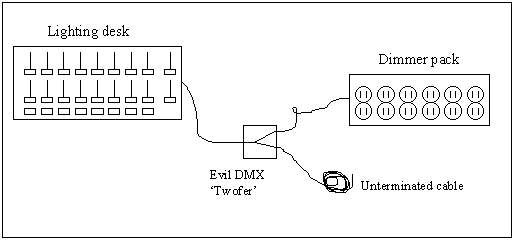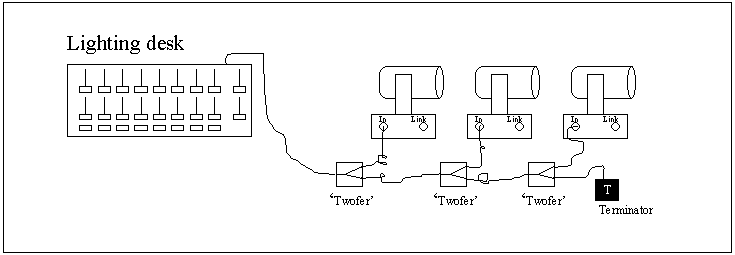![[DMX512 Home]](/web/home.gif)
|
![[Link Finder!]](/unweb/linkfind.gif)
|
|
|
![[DMX512 Home]](/web/home.gif)
|
![[Link Finder!]](/unweb/linkfind.gif)
|
|
|
The book Recommended practice for DMX512 states: Incorrect or missing termination is probably the single most common reason for faulty DMX512 systems.
We agree.
Yet the termination for most DMX512 systems is not designed into the rig, but just "happens". We aim to debunk the mystique of termination, and give simple guidelines on how to terminate.
The data rate for DMX512 signals is 250,000 bits per second. This is fast enough to put a DMX512 signal into the category of signals knows as "radio frequency", or RF. RF signals behave strangely, if you are not used to the characteristics of these signals. For instance, if you have a piece of wire carrying an RF signal, and the end of the wire is just a cut end, then that cut end acts as a "mirror", and "bounces" the signal back down the wire. Radio amateurs and CBers are familiar with this phenomenon, and it's effects, including (the curse of) VSWR.
A somewhat odder effect also occurs, and that is dependent upon the length of the cable. This is particularly noticeable when you have a tee wiring arrangment, like this:

With this arrangement, there is an unterminated length of cable hanging off the spliter ("twofer", to use that great Americanism), and this can cause all sorts of problems. The technical term for this bit of wire hanging off the main bus is a "stub". With just the right length of cable, that stub becomes effectively a short circuit at just the right frequency. Thus although the circuits all check out OK with your multimeter, when DMX is flowing, all sorts of inexplicable odd things happen.
A terminator in DMX512 terms is a simple resistor, of about 120 ohms, connected between the two DMX512 data lines.
Thats it. Nothing fancy, just a few pence (or cents) resistor. A few pennies worth of component are the single most key link in the operation of your entire multi-thousand (in whatever currency) light rig.
Frightening, isn't it?
You can build your own terminators, here's how.
The simple rule is: At the end of each chain of DMX512 receivers there should be a termination resistor.
Thats it, thats all there is to it. But wait - if thats all there is to it, how come most of the time line termination is done just plain wrong?
The main problems are
Take a look at this diagram of a very simple lighting system, and try to work out where the terminator(s), if any are:

How did you do? - zero or one terminators is probably correct, two is possible but less likely, and three or more is unlikely.
So for just a simple system there are lots of possibilities. Lets look at them in a bit more detail...
(But before diving into that, it's helpful if you understand a bit about DMX512 networks, which (paradoxically) is the next chapter in the series...)
It is unlikely that there will be a terminating resistor in the console; since consoles generally drive DMX512 lines directly, and is the only driver on the DMX512 "bus" (thats the technical term for a DMX512 cable that snakes it's way to multiple receivers), it doesn't need terminating.
That just leaves us with the dimmer pack. It may have an internal terminator, or it may not. How can you tell? Deductive method:
The exception to prove the rule: Systems that actively regenerate DMX512 also have an input socket, and a daisy chain output, and some fancy footwork under the covers. When the dimmer is on, then the input socket is internally terminated in the unit, and the output socket is supplied with DMX512 from electronics in the dimmer. This is a freshly regenrated output, and has lots of ability to drive a chain of devices.
When the power fails, a relay completes the circuit between the input and daisy chain sockets, allowing devices further down the chain to continue to function. In this mode the internal terminator is disconnected. It's also worth noting the the DMX512 line power has now dropped down to that supplied by the driving device up the chain, and half your rig may have just plunged into full mirror jitter mode.....
No end-of-line terminating switch or labels on the device? Bummer. Then you have to get a bit scientific, and use a testmeter. A modern, digital testmeter is best, 'cos these can accurately measure resistance of a hundred ohms without frying the circuitry of the device under test.
Use the testmeter to measure the resistance across pins 2 and 3 of the input socket. If it is about 100 ohms, your device is terminated, if it is several K ohms or greater, you are unterminated. Check with the power to the device on and off, it'll probably be the same result in both cases. Now label the device.
Start at step one.
| Step | Test to perform | Result of test | Conclusion | Goto step number | Notes |
|---|---|---|---|---|---|
| 1 | With power ON measure resistance between pin 2 on input and output sockets | <10 ohms. | Output socket is probably simply parallelled to input socket | 2 | |
| >10 ohms | Output socket is being repeated electronically from input signal | 3 | |||
| 2 | With power OFF measure resistance between pin 2 on input and output sockets | <10 ohms | Output socket definitely is simply parallelled to input socket | 4 | |
| >10 ohms | Something strange about this fitting! | Consult engineer | |||
| 3 | With power OFF measure resistance between pin 2 on input and output sockets | <10 ohms | Output socket is electronically driven, but with relay bypass for when the power is off. | 5 | |
| >100 ohms | Output socket is electronically driven, without relay bypass. | 6 | |||
| 4 | With power off, measure resistance between pins two and three on input socket | Resistance is about 100 ohms | Device has paralleled input sockets, and is internally terminated. (bad) | Label it! You're done. |
Type 4 |
| Resistance is above 250 ohms | Device has paralleled input sockets, and is not internally terminated (great) | Label it! You're done. |
Type 1 | ||
| 5 | Measure resistance between pins two and three on input socket with power both on and off | In both cases resistance is about 100 ohms | Device IS terminated, and output socket is electronically repeated with relay bypass (bad) | Label it! You're done. |
Type 4 |
| In both cases resistance is above 250 ohms | Device IS NOT terminated, and output socket is electronically repeated with relay bypass (ok) | Label it! You're done. |
Type 2 | ||
| Resistance is about 100 ohms one way, and something very different the other | Device changes it's mind!, and output socket is electronically repeated with relay bypass (evil) | Label it! You're done. |
Type 5 | ||
| 6 | Measure resistance between pins two and three on input socket | Resistance is about 100 ohms | Device IS terminated, but output is electronically buffered without relay bypass (bad) | Label it! You're done. |
Type 4 |
| Resistance is above 250 ohms | Device IS NOT terminated, but output is electronically buffered without relay bypass (bad) | Label it! You're done. |
Type 3 |


Comments and suggestions are welcomed by the webmaster, please use this
contact form
DMX512.com site and linking information.
And be sure to read our disclaimer.